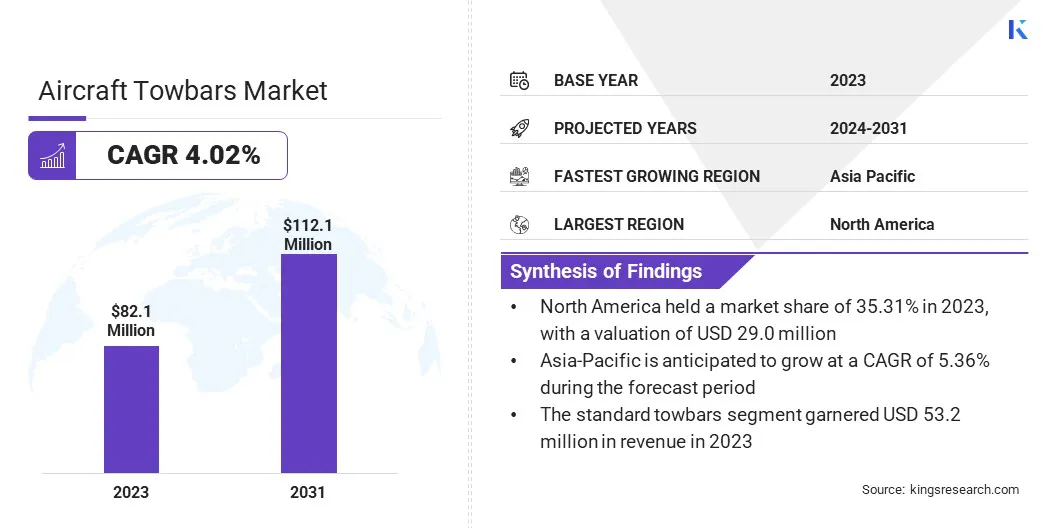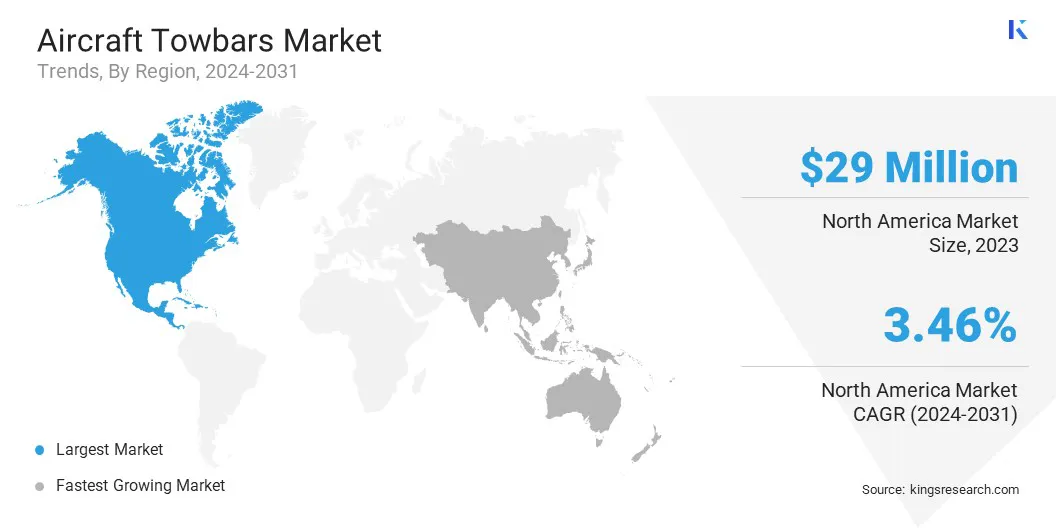Aircraft Towbars Market Size
The global Aircraft Towbars Market size was valued at USD 82.1 million in 2023 and is projected to grow from USD 85.0 million in 2024 to USD 112.1 million by 2031, exhibiting a CAGR of 4.02% during the forecast period. The market is expanding due to the growing demand for ground support equipment.
This demand is further bolstered by increased air travel and the rapid recovery of global aviation. Moreover, rising investments in airport infrastructure and advancements in towbar technology, such as improved safety features and ergonomic designs, are propelling market growth.
In the scope of work, the report includes products offered by companies such as Tronair, AERO Specialties, Inc., BRACKETT AIRCRAFT COMPANY, INC., Dedienne Aerospace, TECHMAN-HEAD, AGSE LLC, K&M airporttechnik GmbH, Langa Industrial S.A.U., HALL Industries, Inc., HYDRO SYSTEMS GmbH & Co. KG, and others.
The aircraft towbars market is experiencing robust growth, mainly due to increasing global aircraft fleets and the expansion of airport infrastructure. Innovations such as automated and adjustable towbars, along with the use of advanced materials, are enhancing operational efficiency and durability.
- In December 2023, the International Air Transport Association (IATA) reported ongoing recovery in air travel, with total traffic approaching pre-pandemic levels. For the year, traffic, measured in revenue passenger kilometers (RPKs), increased by 36.9% compared to 2022, reaching 94.1% of 2019 levels. In December alone, traffic rose by 25.3% compared to December 2022 and reached 97.5% of December 2019 levels.
Airports are upgrading their ground support equipment to handle rising air traffic and improve operational efficiency, which further stimulates the demand for modern towbars. Additionally, the shift toward newer, more efficient towbar models is supported by advancements in technology that reduce maintenance needs and improve overall performance.
Aircraft towbars are specialized ground support equipment used to connect aircraft to towing vehicles for maneuvering on the tarmac or in hangar environments. These tools are essential for pushing or pulling aircraft during maintenance, repositioning, or airport ground operations.
Designed to attach securely to an aircraft's nose or tail landing gear, towbars come in various sizes and configurations to accommodate different aircraft models. They play a critical role in ensuring safe and efficient aircraft handling, especially during non-powered movements. Modern aircraft towbars are built with durable materials and often include adjustable or automated designs to enhance ease of use and efficiency.

Analyst’s Review
The growing demand for efficient ground handling operations is boosting the need for advanced aircraft towbars. With rising air traffic, airports and airlines are investing in reliable and durable equipment to ensure seamless aircraft movement during maintenance and turnaround processes.
- In April 2022, South Korea’s Ministry of Land, Infrastructure, and Transport announced a USD 10.97 billion investment to construct an offshore airport on Gadeok Island,. This underscores the growing need for modern ground support equipment such as towbars to manage the anticipated rise in air traffic.
Key players may leverage this rising demand for advanced ground support equipment by developing innovative and durable aircraft towbars tailored to the needs of expanding airports. By investing in R&D and forming strategic partnerships with airport authorities, they are likely to enhance product offerings, improve efficiency, and capitalize on increasing air traffic demands.
Aircraft Towbars Market Growth Factors
The expanding global fleet of commercial and military aircraft is aiding the growth of the aircraft towbars market. As airlines and defense organizations expand their fleets, they need to enhance their ground handling infrastructure to manage and move aircraft efficiently. Towbars are essential for these operations, enabling precise maneuvering and positioning of aircraft during maintenance and turnaround processes.
The surge in fleet size leads to higher demand for towbars, as airports and ground handling services need to equip themselves with the necessary tools to support the increased volume of aircraft movements. This growing requirement is fueling market expansion. Furthermore, acquisition between key players is contributing to the growth of the market.
- In February 2023, HIFraser Group became the Australian in-country partner for Langa Industrial, a designer and manufacturer of ground support equipment. The companies have signed an exclusive collaboration agreement to supply and provide ongoing support for Langa Industrial's products in Australia.
The development of the market is expected to be hindered by high maintenance costs and the need for frequent upgrades in aircraft towbars, which can be a major burden for operators and airports. Additionally, the increasing shift toward towbarless systems presents a challenge to traditional towbar manufacturers. Key players are mitigating these challenges by investing in research and development to create more durable, cost-efficient towbars that require less maintenance.
Furthermore, they are introducing adaptable designs that support multiple aircraft types, reducing the need for frequent replacements. Additionally, several companies are diversifying their product offerings by integrating towbarless solutions, which helps them stay competitive and meet evolving aircraft towbars market demands.
Aircraft Towbars Industry Trends
The global expansion and modernization of airport infrastructure are propelling the growth of the market. As airports undergo extensive renovations and new developments to manage rising air traffic and enhance operational efficiency, there is an increasing demand for sophisticated ground support equipment, including towbars. These infrastructure advancements necessitate the acquisition of high-quality towbars to ensure effective aircraft handling and movement.
Additionally, the market is experiencing robust growth due to the need to equip newly constructed and upgraded airports with essential towbars. This demand supports improved operational capabilities and streamlined aircraft ground operations, thereby fostering market expansion.
Innovations in towbar design are contributing substantially to the growth of the aircraft towbars market. The introduction of automated and adjustable towbars enhances operational efficiency and user convenience, allowing for quicker and more precise aircraft movements. Incorporating advanced materials and technologies into these towbars improves their durability and reduces maintenance requirements, making them more cost-effective in the long term.
These advancements boost performance and prompt airports and ground handling services to upgrade their equipment by adopting newer models. The market is expanding rapidly, fueled by the surging demand for more efficient and durable towbars that meet the evolving needs of modern aviation infrastructure.
Segmentation Analysis
The global market has been segmented based on product type, aircraft type, end user, and geography.
By Product Type
Based on product type, the market has been categorized into standard towbars and motorized towbars. The standard towbars segment led the aircraft towbars market in 2023, reaching a valuation of USD 53.2 million. Standard towbars, known for their durability and compatibility with various aircraft models, remain the preferred choice for numerous ground handling operations.
Their cost-effectiveness and ease of maintenance make them ideal for smaller airports and airlines looking for reliable solutions. As air travel demand continues to recover there is a growing need for efficient ground support equipment. This rise in need is further boosting the demand for standard towbars in both developed and developing markets worldwide.
By Aircraft Type
Based on aircraft type, the market has been categorized into commercial aircraft, military aircraft, general aviation, cargo aircraft, and others. The commercial aircraft segment captured the largest aircraft towbars market share of 44.08% in 2023. The commercial aircraft segment is further categorized into narrow-body and wide-body. As commercial aviation recovers, airlines are increasingly investing in ground support equipment to enhance operational efficiency.
This growth is further supported by the rise in airport infrastructure development and fleet expansion initiatives by major airlines. Towbars are crucial for ground handling of various commercial aircraft models. Additionally, technological advancements in towbar designs are improving efficiency, which is boosting demand in commercial aircraft.
By End User
Based on end user, the market has been categorized into airports, aircraft manufacturers, maintenance, repair, and overhaul services, private aircraft owners, and others. The airports segment is expected to garner the highest revenue of USD 53.3 million by 2031. The airports segment is further divided into major hubs and regional airports.
With increasing investments in airport infrastructure, particularly in emerging economies, the demand for advanced ground handling equipment such as aircraft towbars is rising. Airports require reliable, efficient towbars to ensure smooth aircraft movements during maintenance and turnaround operations.
Moreover, the adoption of automation and smart technologies in airport operations is highlighting the need for innovative, durable towbars. As global air travel rebounds, airport authorities are prioritizing operational efficiency, contributing to the growth of the segment.
Aircraft Towbars Market Regional Analysis
Based on region, the global market has been classified into North America, Europe, Asia-Pacific, MEA, and Latin America.

North America aircraft towbars market accounted for the largest market share of 35.31% in 2023, with a valuation of USD 29.0 million. The region’s strong aviation industry, along with continuous investments in airport modernization and expansion projects, is fueling the demand for advanced ground support equipment.
The United States, in particular, is investing heavily in upgrading airport infrastructure to improve efficiency and handle increasing passenger traffic. Furthermore, technological advancements in towbar designs and the rising adoption of towbarless systems are expected to propel the growth of the North America market.
Asia-Pacific is anticipated to witness the fastest growth at a CAGR of 5.36% over the forecast period. This expansion is largely attributed to booming air travel, expanding airport infrastructure, and increasing fleet sizes. Countries such as China and India are investing heavily in airport development to accommodate rising passenger traffic and support their growing aviation sectors.
- According to a report by the International Air Transport Association (IATA), the number of passengers is estimated to double to 8.2 billion by 2037. China is anticipated to emerge as the largest aviation market by 2024.
Major infrastructure projects, such as new airport terminals and expansions of existing facilities, are increasing the demand for advanced ground support equipment. Additionally, technological advancements and the short toward modernizing airport operations are boosting the adoption of efficient and durable towbars. As the region's aviation infrastructure continues to develop, the demand for aircraft towbars is expected to increase notably.
Competitive Landscape
The global aircraft towbars market report will provide valuable insight with an emphasis on the fragmented nature of the industry. Prominent players are focusing on several key business strategies such as partnerships, mergers and acquisitions, product innovations, and joint ventures to expand their product portfolio and increase their market shares across different regions.
Companies are implementing impactful strategic initiatives, such as expanding services, investing in research and development (R&D), establishing new service delivery centers, and optimizing their service delivery processes, which are likely to create new opportunities for market growth.
List of Key Companies in Aircraft Towbars Market
- Tronair
- AERO Specialties, Inc.
- BRACKETT AIRCRAFT COMPANY, INC.
- Dedienne Aerospace
- TECHMAN-HEAD
- AGSE LLC
- K&M airporttechnik GmbH
- Langa Industrial S.A.U.
- HALL Industries, Inc.
- HYDRO SYSTEMS GmbH & Co. KG
Key Industry Development
- March 2023 (Partnership): Dedienne Aerospace announced a partnership with BARFIELD Inc. to service and distribute its Ground Support Test Equipment. This collaboration aims to enhance the companies' relationship and deliver additional value to their global customer base.
The global aircraft towbars market is segmented as:
By Product Type
- Standard Towbars
- Motorized Towbars
By Aircraft Type
- Commercial Aircraft
- Military Aircraft
- Fighters
- Transport
- Surveillance
- General Aviation
- Private Aircraft
- Small Aircraft
- Cargo Aircraft
- Others
By End User
- Airports
- Major Hubs
- Regional Airports
- Aircraft Manufacturers
- Maintenance, Repair, and Overhaul (MRO) Services
- Private Aircraft Owners
- Others
By Region
- North America
- Europe
- France
- U.K.
- Spain
- Germany
- Italy
- Russia
- Rest of Europe
- Asia-Pacific
- China
- Japan
- India
- South Korea
- Rest of Asia-Pacific
- Middle East & Africa
- GCC
- North Africa
- South Africa
- Rest of Middle East & Africa
- Latin America
- Brazil
- Argentina
- Rest of Latin America


